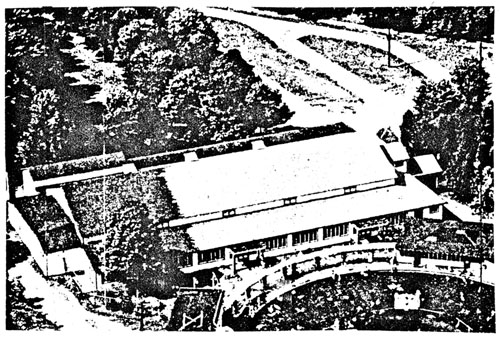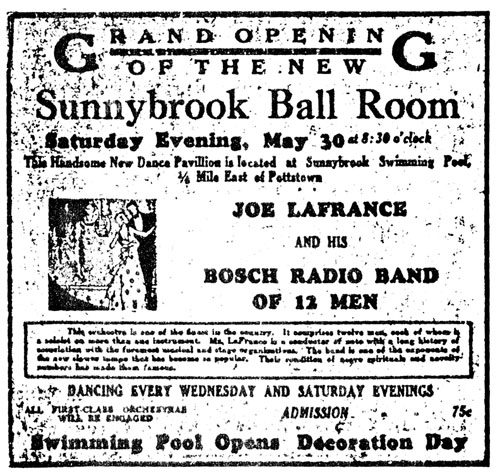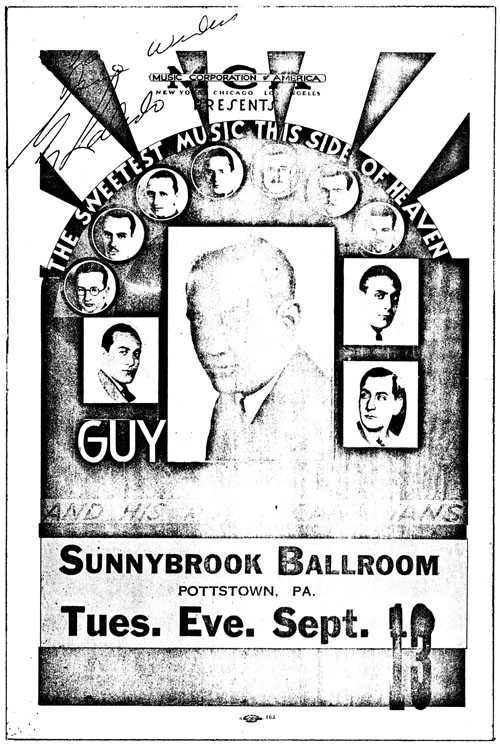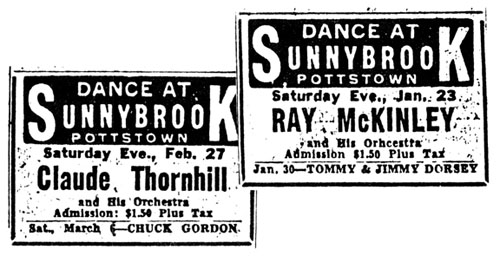|
Home : Quarterly Archives : Volume 26 |
Tredyffrin Easttown Historical Society |
|
Source: January 1988 Volume 26 Number 1, Pages 25–34 Sunnybrook Ballroom Sunnybrook Ballroom is one of the few remaining large dance halls of the pre-World War II era still in existence and still operating. For its first three decades or so, one of the big "name" dance bands played here every Saturday night, New Year's Eve, and sometimes during the week or on other holidays. Located just east of Pottstown, it attracted dancers from a 50-mile radius, including our area and all the Main Line, who came to dance to -- or in some cases just to listen to and watch -- virtually all the top dance bands in the country. It was during the Depression, in early 1931, that Ray Hartenstine Sr., later known as "the dean of the big band ballroom operators", decided to add a dance pavilion to the swimming pool and picnic grove he had built five years earlier on a portion of the old "Sunnybrook Farm". Raymond C. Hartenstine was born in Sanatoga, near Pottstown, in 1894, one of five children of Irvin S. and Sallie Jane (Christman) Hartenstine, and was raised in nearby Limerick. During the First World War he enlisted in the army, and was stationed at Camp Meade in Maryland. There he was assigned carpentry duty, engaged in building the camp. After his discharge he went into the construction business in Pottstown; among his projects were the Pottstown Mercury building, and a number of stores and houses in the area. While he was in the service he also married Sara Rebecca Kepler, at "Sunnybrook Farm". The farm had been in the possession or the Kepler-Bickel families since colonial times, and was a dairy farm until the early 1920s.
The young couple made their home on the farm, as did his wife's sister and her husband, and the two brothers-in-law formed the partnership of Buchert and Hartenstine. The swimming pool and picnic grove were built there in 1926. On April 6, 1931 Hartenstine wrote, in a notebook that he kept, that on that day they "started to Clear Ground for [the new] Dance Pavillion." Ten days later he noted they were laying down the first floor; two days after that they started to put up the sides of the building; by April 29th the plasterers and the electricians started to work; and on May 6th the roof over the pavillion was completed. The finished ballroom opened on Memorial Day, less than eight weeks after its construction was started. "Modern in every detail and spacious enough to seat 1500 persons at a banquet," it was reported in the Pottstown Mercury the next day. "the new building ranks with the finest to be found at any place in the East. ... [It] attracted upward of a thousand persons to the opening and the beauty of the building excited the admiration of all who were on hand for the opening dance." (In his notebook, for that day, Hartenstine simply noted, "Open Pool & Dance Floor. Very Hot.")
The new dance pavilion was 96 feet wide and 152 feet long, with an 18-feet high ceiling. The floor was made of narrow maple hardwood strips, and is still considered to be one of the finest dance floors any place. Six years later the ballroom was extended, making it 176 feet long altogether. (The addition was put on in less than a week: "We started on a Saturday night just as the band finished," Hartenstine later recalled," and had the dance floor ready in time for the following Saturday. We never missed a dance while building that addition.") At the far end, as you came into the ballroom, was (and is) a stage for the musicians, while opposite it, over the entrance, was a small balcony. Aside from cloak rooms and rest rooms at the near end of the hall and a small area for the soda fountain at the far right, the rest of the huge ballroom was for the dancers. The first band to play at Sunnybrook Ballroom, at its opening on Memorial Day 1931, was Joe LaFrance and his Bosch Radio Band, advertised as "one of the finest in the country". It comprised "twelve men, each of whom is a soloist on more than one instrument" and was described as "one of the exponents of the new slower tempos that have become so popular". (Even though some writers consider the decade from 1935 to 1945 as the "Big Band Era", in the early 1930s there were already a number of well-known "name" bands, largely as a result of radio broadcast:;. The first dance band to broadcast over the radio, incidentally, is said to have been Paul Specht's orchestra, over station WWM in Detroit in 1920; in the fall of 1932 he played at Sunnybrook.) Before the end of 1931 the Casa Loma Orchestra, with, as George Simon described it in his The Big Bands, "an exciting and refreshing mixture of arranged big band jazz and slow sentimental ballads matched by no other bands of the day", had made three appearances at the new dance pavilion, and in 1932 the bands of Kay Kyser, Isham Jones, Horace Heidt, Jan Garber, Wayne King, Guy Lombardo, Ozzie Nelson (featuring Harriet Hilliard), Rudy Vallee, and Ted Weems, among others, played there for their first times. Another band that played there in the summer of 1932 was that of Blanche Calloway, Cab Calloway's sister. It was one of several notable black bands -- they were called negro bands then -- that appeared at Sunnybrook during the first few years. Others included Cab Calloway, the "Prince of Heigh-de-ho"; Fletcher Henderson, whose band always included some of the greatest jazz musicians and who later became an arranger for Benny Goodman; Noble Sissle, Earl "Fatha" Hines, Claude Hopkins, Don Redman, Luis Russell, and Jimmie Lunceford. Later Count Basie, Louis Armstrong, Duke Ellington and Lionel Hampton would also be added to this list. Coming to Sunnybrook for the first time in 1933 were, among others, Ben Bernie and All the Lads, Vincent Lopez, George Olsen, Eddy Duchin, Fred Waring, Mal Hallett, and the "King of Jazz" himself (and undoubtedly the best known of the early "name" bands), Paul Whiteman and his Orchestra. Hal Kemp and Freddy Martin made their debuts at Sunnybrook in 1934. And this was all before the so-called "Big Band Era"! During these early years, Hartenstine frequently made notes on a band's performance at the gate. Some were "Poor", "Fair", or "Not so Good". Others, however, were considered "Good", "Good, but not quite so good as before", "Good as a show band" (that was Horace Heidt), "Good, [but] not sensational", and even "Very Good". The highest accolade was reserved for Guy Lombardo: "None better!" While a few of the bands at that time were paid a flat fee, most of them worked on a guarantee plus commission basis, and some of them simply for a percentage of the admission receipts. In his note book, Hartenstine kept entries of the various payment arrangements in these early years. For the New Year's Eve dance on December 31, 1932, for example, Ozzie Nelson and Harriet Hilliard were paid "60 percent of gate, no guarantee. $575.25". Hartenstine also noted that it was "Very Cold, had 1258 people". (The admission price was 75 cents-for New Year's Eve!) Incidentally, fifteen months later, in March 1934, the Nelsons' band's popularity had grown to the extent that they were paid "$1,000 flat". Other entries in the note book, showing the various types of financial arranqements with the bands, include, for Noble Sissle in January 1933, "$400, [but] if gross receipts do not exceed $450, $40 less", and for Ted Weems, two months later in March, "$600 or 60%". (When one band arrived late and, as Hartenstine noted, "drunk and disorderly", it was paid only "one half of the contract price".) In the summer of 1934, dances were also held on Wednesday nights, with the music provided by a local band, LeRoy Wilson. His band also occasionally filled in on a Saturday night when one of the name bands could not be booked for that date.
In early 1935, before their historic falling out that spring, the Dorsey Brothers Orchestra appeared twice; when they reunited eighteen years later, as the Tommy Dorsey Orchestra Featuring Jimmy Dorsey, they played together at Sunnybrook on three more occasions. In the meantime, Tommy Dorsey was at Sunnybrook with his band twenty-four times, setting new attendance records with each appearance in the early 1940s, and Jimmy Dorsey and his orchestra played there eleven times. In June 1935 Benny Goodman -- not yet the "King of Swing"; it was still two months before his triumphal opening at the Palomar in California - played the first of his thirteen appearances at Sunnybrook. He and his band were paid $250 for this first one-night stand there. It was at Sunnybrook two years later, George Simon recalled, that Goodman introduced his new vocalist, Martha Tilton, as "a singer from Hollywood who's going places", and then quickly added, when she missed her cue, "She's not going places; she's already gone!" On another occasion, the King himself "missed his cue" and arrived a couple of hours late, having got caught in the traffic jam caused by his band's appearance at the ballroom that night. (He usually traveled by automobile rather than in the bus with the rest of the band.) Other bands coming to Sunnybrook for the first time during the next two years included Sammy Kaye, Bob Crosby, Russ Morgan, Shep Fields, Woody Herman, Ray Noble (whose band, incidentally, was put together by Glenn Miller), Artie Shaw, Bunny Berigan, and a Philadelphia band that was soon to attain national recognition, Jan Savitt and the Tophatters. In the summer of 1937, national recognition also came to Sunnybrook itself. When Hal Kemp played there in June, Life magazine covered the engagement as one of its series "Life Goes to a Party", and early the next month featured it in a three-page picture-article. "Saturday nights at Sunnybrook Park Ballroom near Pottstown, Pa.," it reported, "2,000 or 3,000 boys and girls come from 40 miles around and gladly pay $1 (plus 14 cents tax) to listen to the music of 'Big Name' bands . . . The particular Saturday night shown herewith found Hal Kemp and his band at Sunnybrook Park --a typical stop on the itinerary of a crack band which in this case had played in Manhattan Beach earlier in the day and was due in Columbus, Ohio [going by train from Paoli at 2:30 a.m.] Sunday night." The addition to the ballroom, completed without missing a dance, was also made in 1937. Over the next two years, among the bands coming to Sunnybrook for their first of several visits were Larry Clinton, Harry James, Charlie Barnet, Will Bradley, Gene Krupa, Glenn Miller, Charlie Spivak, Vaughn Monroe, Tony Pastor, and Claude Thornhill. Even in the late 1930s and early 1940s, most of the bands were paid on a guarantee plus a percentage of the admissions basis. Some of the better known bands might have a guarantee of as much as $1000, but generally the bands came in for between $450 and $750. If a band was worth the money, it would get it from its share of the gate. Over the years, Hartenstine built up a personnel acquaintance and friend ship with many of the band leaders, who would tell their agents to include Sunnybrook in their itinerary when they went out on the road. It was also a convenient location for a one-night stop for bands going into or coming out of New York on tour. Ray Hartenstine Jr. has recalled that in the early days, after a band came off the stage at Sunnybrook for the night, "the band's road manager would call three or four hotels in New York to see which one wasn't full; then they'd leave here at about one o'clock and get there at about 4:00 or 4:30 a.m. and book into the hotel for Sunday night, getting two nights for the price of one". The size of the ballroom, and its capacity to accommodate a large crowd, also helped Sunnybrook attract the best bands. The attendance record, over 7300 people, was set in February 1942 by Glenn Miller during his last road trip before disbanding his orchestra to go into the U.S. Army Air Corps in September. Rather surprisingly, Glenn Miller and his band played at Sunnybrook only three times during the eight years the band was in existence. (After the war, however, the Glenn Miller Orchestra, led by Tex Beneke, played there seventeen times and, starting a decade later, the Glenn Miller Orchestra conducted by Ray McKinley made nineteen appearances at Sunnybrook.) But overall, it was Tommy Dorsey who drew the best, with crowds of more than 6000 on several occasions just before Glenn Miller's record. "If we wanted to make money to buy something or do something," Ray Hartenstine Jr. later recalled, "we brought Tommy Dorsey in, sent him a cable." A number of factors affected how a band did, including, of course, the weather. Sometimes a band would have a big following in one area, but not do well in another. A recent hit recording could also make a big difference. By the late 1930s, records and jukeboxes were perhaps the most important factor in a band's success; as Leo Walker, in his The Era of the Great Dance Bands, pointed out, almost every band leader who rose to the top during the '30s "got there as a result of one or more hit records", adding that "the jukebox was the best friend the band leader had". (Of the ten top-selling records in June 1940, not so incidentally, three were recorded by Glenn Miller and two by Tommy Dorsey.) The early 1940s were the halcyon years at Sunnybrook. The list of bands that played at the ballroom in early 1942, for example, reads almost like a "Who's Who of the Big Band Era". Playing on successive Saturday nights during the first five months of that year were Will Osborne, Will Bradley, Sonny Dunham, Harry James, Sammy Kaye, Claude Thornhill, Eddy Duchin, Glenn Miller, Tommy Tucker, Tommy Reynolds, Bob Chester, Charlie Barnet, Alvino Rey, Tony Pastor, Casa Loma, Vaughn Monroe, Tommy Dorsey, Dick Rogers, Ray McKinley, Benny Goodman, and Bunny Berigan! But after the dance on July 18th of that year, Sunnybrook closed "for the duration" of the Second World War. Not only was it feeling the effects of gasoline rationing and the military draft, but many of the band leaders and their musicians were also either in the service themselves, or playing in US0 shows, entertaining troops all over the world. The ballroom reopened on September 8, 1945 with Vaughn Monroe and his orchestra. Before the year was over a number of old favorites, including Benny Goodman, Woody Herman, Charlie Spivak, Charlie Barnet, and Tommy Dorsey, were back, along with newcomers such as Randy Brooks, Buddy Morrow, and Elliot Lawrence; with a local band from radio station WCAU that was to become one of the most popular dance bands during the next decade. During the next few years, some of the older bands, like Les Brown, Dick Jurgens, and Lawrence Welk, who for some reason had never played at Sunnybrook before, made their initial appearance in the ballroom along with some of the newer bands, among them Stan Kenton, Bobby Sherwood, Ralph Flanagan, Ray Anthony, Les Elgart, and Hal Mclntyre. With many of the bands, especially the better known ones, now asking for much larger guarantees, the admission price was also increased after the war. Where it had cost $.75 or $.90 plus tax to get in in the '30s, and maybe $1.25 in the early '40s, in the fall of 1945 the price was set at $2.00 plus tax, or a total of $2.40 altogether, for the big names. Otherwise, it was much the same. The ballroom was still run on the assumption, as Ray Hartenstine Jr. put it, that "it is a privilege to come to Sunnybrook", and that it was a place where there would be no trouble. It was an atmoisphere appreciated and respected by both the bands that played there, and the people who came to listen and dance. Everybody was well dressed, and if anyone got out of line in any way, he or she was asked to leave. To handle a crowd of 2000 people, about 20 employees were needed: six to sell and take tickets; four hat check girls (maybe six in the winter); six at the soda fountain (only soft drinks were sold or served); and three or four in the parking lot. Both before and after the war there were regular remote radio pickups from Sunnybrook over station WRCV in Philadelphia and also, from time to time, on nation-wide broadcasts over the CBS or NBC networks - as Sunnybrook was included as part of a regular series of pickups each week from ballrooms and hotels in different parts of the country. This was, of course, good publicity -- but whether or not it helped at the box office was moot. Advertisements were also run on a regular basis in some thirteen or fifteen newspapers in the area.
"The ten year period comprising the 1950s," as Leo Walker observed, "was one of steady decline of the dance band business." In the late '40s and early '50s, a number of the leaders of the top name bands passed away. Others retired, or found the costs and hassles (of which there were many) of going on the road more than they wanted to put up with. Phonograph records now featured vocalists or vocal groups; in 1955 none of the 35 top-selling records was cut by a dance band, At the same time, television was replacing night-time radio in many homes, and the remote pickups from hotels and ballrooms were less frequent. Nevertheless, during the 1950s, many of the remaining traveling name bands continued to appear at Sunnybrook, though some of them were now playing under new leaders: the Tommy Dorsey Orchestra, conducted by Warren Covington; the Jimmy Dorsey Orchestra, led by Lee Castle; the Glenn Miller Orchestra, now conducted by Ray McKinley. And there were also new bands and band leaders, among them Billy May, the Sauter-Finegan Orchestra; Ralph Marterie, Larry Elgart, Buddy Rich, Neal Hefti, Maynard Ferguson, and Si Zentner. When Ted Heath and his orchestra came over from England in 1958, he played at Sunnybrook, although union rules required that a local band supply the music for dancing. Actually, one of the criticisms of many of the new big bands (and some of the older ones too) was that they no longer played dance music, but featured more concert-type big band jazz arrangements. As one critic put it, "Bands started playing for themselves instead of the public. No one could dance to what most of them played." As for rock music, when Bill Haley and the Comets played at Sunnybrook in 1957, another band was also booked for the dancing! With the decline in the number of good traveling dance bands, those who did go on the road played at the ballroom with a greater frequency-- some as often as four or five times a year -- and it was necessary to fill in more Saturday nights with good local bands, among them Al Raymond, Bob Harry, Eddie Grady, Buddy Williams, George Sommers, and Arlen Saylor, playing the traditional big band arrangements. (George Sommers played at Sunnybrook 21 times between August 1948 and May 1959; Buddy Williams appeared 50 times between September 1948 and January 1960; and Arlen Saylor, whose band became known as the Sunnybrook Orchestra, played there 29 times between September 1960 and April 1963.) In 1952 and 1953, and again from 1959 through 1962, the ballroom was closed during the summer months. In the summer of 1963 a change of policy was finally, and reluctantly, made. With the high costs of entertainment, utilities, maintenance, and personnel, Sunnybrook could no longer exist on one-night stands once a week. A restaurant and bar, The Colonial Inn and Tavern, were added next to the ballroom, and for the first time a liquor license was obtained. With the changing times, it was simply a matter of survival. In May 1964, Sunnybrook reopened on an every-day basis, with small combos or local bands providing music for dancing on Saturday nights. The ballroom is now used primarily for various functions: high school proms, wedding receptions, charity balls, community banquets, political rallies and dinners (George Bush has twice been a guest speaker), and trade shows. Every fall there is a three-day polka festival. During the first three decades of Sunnybrook Ballroom, more than 345 bands -- from Irving Aaronson and his Commanders to Bob Zurke -- played there. The name band that appeared most frequently was Tommy Tucker's, which played in the ballroom on thirty-one occasions. (Many years later his vocalist still remembered that one night there, just as she started to sing "On the Sunny Side of the Street", there was a cloudburst and huge downpour outside!) Other bands that appeared at Sunnybrook more than twenty times during this period were Sammy Kaye, Tommy Dorsey, Casa Loma, Buddy Morrow, and Claude Thornhill. But the odds are that your favorite big name band, whichever one it was, played there at least once! After Ray Hartenstine Sr. died in 1972, his twin sons Robert and Ray Jr., and their sister Doris Drumheller, became partners of Sunnybrook Enterprises, and continued the tradition of the famed ballroom. And whenever possible, even though it is now only four or five times a year, they book one of the few remaining old name bands for a dinner-dance. For many, it is a reminder of Sunnybrook's heydey as "the home of the big bands"-- when virtually all the big name dance bands appeared there on Saturday nights and New Year's Eve. TopSources Conversations with Ray Hartenstine Jr. Notebooks of Ray Hartenstine Sr. for 1931 through 1935 Files of the West Chester Daily Local News and Pottstown Mercury in the Chester County Historical Society, Historical Society of Montgomery County, and Pottstown Library George T. Simon, The Big Bands. New York: MacMillan 1967 Leo C. Walker, The Era of the Great Dance Bands. Garden City: Doubleday 1964 Personal recollections |



